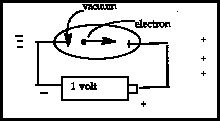Some Particle Properties
An Article Written Originally for Midlevel TeachersA particle, increasing its speed because of some force acting on it, gains energy of motion. An electron (negatively charged) gains one electron volt (eV) of energy in accelerating through a vacuum from the negative end to the positive end of a one-volt battery. The one eV of energy is given up to other particles as the electron crashes into the positive end.
A proton (positively charged) traveling from positive to negative pole through the vacuum would also gain one eV of energy and give it up in its collision with particles in the negative end. This proton collision is similar to the proton beam collision with a target at Fermilab, but at Fermilab the proton energy is much greater.
As a particle's speed approaches the speed of light (300,000,000 meters per second), most of the energy gained is not in the form of greater speed but as greater mass. When the particle slows down or collides with another particle the extra mass may be converted back to energy of motion or it may form new particle mass. For example, a proton at its maximum speed in the Fermilab accelerator has more than 800 times the mass it had when not moving (rest mass) and the mass may appear as new particles after a collision.
Since energy converts to mass and mass converts to energy ( Einstein's equation E=mc 2 ) both are aspects of the same thing. Since subatomic masses are so small, it is easiest to express them in the very small electron-volt (eV) unit.*
*The approximate conversion factors are:1 gram=6 x 1026 million electron volts (MeV)
1 electron volt=1.6 x 10-33 grams
1 MeV=1.6 x 10-27 grams
Every particle has either no rest mass or a rest mass that is unchanging. For example, an electron's rest mass is .511 MeV, a proton's is 936.2 MeV, and an upsilon's is 9402 MeV. A photon (a particle of light) has no rest mass, only mass when in motion at its normal speed--the speed of light.
Every particle is either neutral or has an electrical charge that never changes. The charge of an electron is negative. Its magnitude is often used as a unit of electric charge (e). An alpha particle (2 protons and 2 neutrons) has 2 e positive charges. (The quantity of charge "e" exists in both positive and negative form.)
There are other quantifiable properties of particles including spin and magnetism. The quark, considered to be one of the most fundamental particles, has additional properties given fanciful names such as color and flavor.
Back
